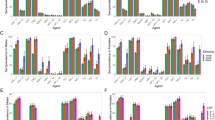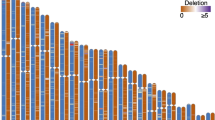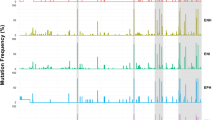Abstract
Populations and individuals differ in susceptibility to infections because of a number of factors, including host genetic variation. We previously demonstrated that differences in antibody titer, which reflect infection history, are significantly heritable. Here we attempt to identify the genetic factors influencing variation in these serological phenotypes. Blood samples from >1300 Mexican Americans were quantified for IgG antibody level against 12 common infections, selected on the basis of their reported role in cardiovascular disease risk: Chlamydia pneumoniae; Helicobacter pylori; Toxoplasma gondii; cytomegalovirus; herpes simplex I virus; herpes simplex II virus; human herpesvirus 6 (HHV6); human herpesvirus 8 (HHV8); varicella zoster virus; hepatitis A virus (HAV); influenza A virus; and influenza B virus. Pathogen-specific quantitative antibody levels were analyzed, as were three measures of pathogen burden. Genome-wide linkage and joint linkage and association analyses were performed using ~1 million SNPs. Significant linkage (lod scores >3.0) was obtained for HHV6 (on chromosome 7), HHV8 (on chromosome 6), and HAV (on chromosome 13). SNP rs4812712 on chromosome 20 was significantly associated with C. pneumoniae (P=5.3 × 10−8). However, no genome-wide significant loci were obtained for the other investigated antibodies. We conclude that it is possible to localize host genetic factors influencing some of these antibody traits, but that further larger-scale investigations will be required to elucidate the genetic mechanisms contributing to variation in antibody levels.
Similar content being viewed by others
Log in or create a free account to read this content
Gain free access to this article, as well as selected content from this journal and more on nature.com
or
References
Klein NP, Fireman B, Enright A, Ray P, Black S, Dekker CL : A role for genetics in the immune response to the varicella vaccine. Pediatr Infect Dis J 2007; 26: 300–305.
Jacobson RM, Ovsyannikova IG, Poland GA : Genetic basis for variation of vaccine response: our studies with rubella vaccine. Paediatr Child Health 2009; 19: S156–S159.
Duah NO, Weiss HA, Jepson A, Tetteh KK, Whittle HC, Conway DJ : Heritability of antibody isotype and subclass responses to Plasmodium falciparum antigens. PLoS One 2009; 4: e7381.
Williams-Blangero S, Vandeberg JL, Blangero J, Teixeira AR : Genetic epidemiology of seropositivity for Trypanosoma cruzi infection in rural Goias, Brazil. Am J Trop Med Hyg 1997; 57: 538–543.
Besson C, Amiel C, Le-Pendeven C et al: Strong correlations of anti-viral capsid antigen antibody levels in first-degree relatives from families with Epstein-Barr virus-related lymphomas. J Infect Dis 2009; 199: 1121–1127.
Rubicz R, Leach CT, Kraig E et al: Genetic factors influence serological measures of common infections. Hum Hered 2011; 72: 133–141.
Kuparinen T, Seppala I, Jylhava J et al: Genome-wide association study does not reveal major genetic determinants for anti-cytomegalovirus antibody response. Genes Immun 2012; 13: 184–190.
Mitchell BD, Kammerer CM, Blangero J et al: Genetic and environmental contributions to cardiovascular risk factors in Mexican Americans. The San Antonio Family Heart Study. Circulation 1996; 94: 2159–2170.
Hunt KJ, Lehman DM, Arya R et al: Genome-wide linkage analyses of type 2 diabetes in Mexican Americans: the San Antonio Family Diabetes/Gallbladder Study. Diabetes 2005; 54: 2655–2662.
Puppala S, Dodd GD, Fowler S et al: A genomewide search finds major susceptibility loci for gallbladder disease on chromosome 1 in Mexican Americans. Am J Hum Genet 2006; 78: 377–392.
Cheng ML, Woodford SC, Hilburn JL, VandeBerg JL : A novel system for storage of sera frozen in small aliquots. J Biochem Biophys Methods 1986; 13: 47–51.
Almasy L, Blangero J : Multipoint quantitative-trait linkage analysis in general pedigrees. Am J Hum Genet 1998; 62: 1198–1211.
Rubicz R, Yolken R, Drigalenko E et al: A genome-wide integrative genomic study localizes genetic factors influencing antibodies against Epstein-Barr virus nuclear antigen 1 (EBNA-1). PLoS Genet 2013; 9: e1003147.
Spence MA, Westlake J, Lange K : Estimation of the variance components for dermal ridge count. Ann Hum Genet 1997; 41: 111–115.
Heath SC : Markov chain Monte Carlo segregation and linkage analysis for oligogenic models. Am J Hum Genet 1997; 61: 748–760.
Heath SC, Snow GL, Thompson EA, Tseng C, Wijsman EM : MCMC segregation and linkage analysis. Genet Epidemiol 1997; 14: 1011–1016.
Price AL, Patterson NJ, Plenge RM, Weinblatt ME, Shadick NA, Reich D : Principal components analysis corrects for stratification in genome-wide association studies. Nat Genet 2006; 38: 904–909.
Rubicz R, Leach CT, Kraig E et al: Seroprevalence of 13 common pathogens in a rapidly growing U.S. minority population: Mexican Americans from San Antonio, TX. BMC Res Notes 2011; 4: 433.
Devlin B, Roeder K : Genomic control for association studies. Biometrics 1999; 55: 997–1004.
Cohen-Eliav M, Golan-Gerstl R, Siegfried Z et al: The splicing factor SRSF6 is amplified and is an oncoprotein in lung and colon cancers. J Pathol 2013; 229: 630–639.
Zhan P, Suo LJ, Qian Q et al: Chlamydia pneumoniae infection and lung cancer risk: a meta-analysis. Eur J Cancer 2011; 47: 742–747.
Fan T, Lu H, Hu H et al: Inhibition of apoptosis in chlamydia-infected cells: blockade of mitochondrial cytochrome c release and caspase activation. J Exp Med 1998; 187: 487–496.
Swanson CM, Sherer NM, Malim MH : SRp40 and SRp55 promote the translation of unspliced human immunodeficiency virus type 1 RNA. J Virol 2010; 84: 6748–6759.
Tranell A, Tingsborg S, Fenyo EM, Schwartz S : Inhibition of splicing by serine-arginine rich protein 55 (SRp55) causes the appearance of partially spliced HIV-1 mRNAs in the cytoplasm. Virus Res 2011; 157: 82–91.
Zeng H, Irwin ML, Lu L et al: Physical activity and breast cancer survival: an epigenetic link through reduced methylation of a tumor suppressor gene L3MBTL1. Breast Cancer Res Treat 2012; 133: 127–135.
Newman H, Gooding C : Viral ocular manifestations: a broad overview. Rev Med Virol 2013; 23: 281–294.
Ogawa-Goto K, Tanaka K, Gibson W et al: Microtubule network facilitates nuclear targeting of human cytomegalovirus capsid. J Virol 2003; 77: 8541–8547.
Fish KN, Britt W, Nelson JA : A novel mechanism for persistence of human cytomegalovirus in macrophages. J Virol 1996; 70: 1855–1862.
Espinola-Klein C, Rupprecht HJ, Blankenberg S et al: Impact of infectious burden on extent and long-term prognosis of atherosclerosis. Circulation 2002; 105: 15–21.
Zhu J, Quyyumi AA, Norman JE et al: Effects of total pathogen burden on coronary artery disease risk and C-reactive protein levels. Am J Cardiol 2000; 85: 140–146.
Epstein SE, Zhu J, Burnett MS, Zhou YF, Vercellotti G, Hajjar D : Infection and atherosclerosis: potential roles of pathogen burden and molecular mimicry. Arterioscler Thromb Vasc Biol 2000; 20: 1417–1420.
de-The G, Geser A, Day NE et al: Epidemiological evidence for causal relationship between Epstein-Barr virus and Burkitt's lymphoma from Ugandan prospective study. Nature 1978; 274: 756–761.
Henle W, Henle G, Ho HC et al: Antibodies to Epstein-Barr virus in nasopharyngeal carcinoma, other head and neck neoplasms, and control groups. J Natl Cancer Inst 1970; 44: 225–231.
Acknowledgements
We thank the participants of the San Antonio Family Heart Study and the San Antonio Family Diabetes/Gallbladder Study. We also thank Mr Barry Grubbs and Ms Bogdana Krivogorsky for their assistance in performing the antibody assays. This work is supported by grants from the US National Heart, Lung, and Blood Institute (HL045522 and HL080149) and the National Institute for Mental Health (MH078143, MH078111, and MH083824). Serological assays were supported in part by the Stanley Medical Research Institute. The statistical computer package SOLAR was supported by a grant from the US National Institute of Mental Health (MH059490). Analyses were conducted in facilities constructed with support from the National Center for Research Resources (RR017515) and a gift from the SBC Foundation. The National Institutes of Health LRP for health disparities research (L60 MD003255) provided additional support.
Author information
Authors and Affiliations
Corresponding author
Ethics declarations
Competing interests
The authors declare no conflict of interest.
Additional information
Supplementary Information accompanies this paper on European Journal of Human Genetics website
Rights and permissions
About this article
Cite this article
Rubicz, R., Yolken, R., Drigalenko, E. et al. Genome-wide genetic investigation of serological measures of common infections. Eur J Hum Genet 23, 1544–1548 (2015). https://doi.org/10.1038/ejhg.2015.24
Received:
Revised:
Accepted:
Published:
Issue date:
DOI: https://doi.org/10.1038/ejhg.2015.24
This article is cited by
-
Distinct genetic architectures and environmental factors associate with host response to the γ2-herpesvirus infections
Nature Communications (2020)
-
Human genetic variants and age are the strongest predictors of humoral immune responses to common pathogens and vaccines
Genome Medicine (2018)
-
The complement system: a gateway to gene–environment interactions in schizophrenia pathogenesis
Molecular Psychiatry (2017)
-
Inter-individual variability and genetic influences on cytokine responses to bacteria and fungi
Nature Medicine (2016)
-
Association of 4p14 TLR locus with antibodies to Helicobacter pylori
Genes & Immunity (2015)



